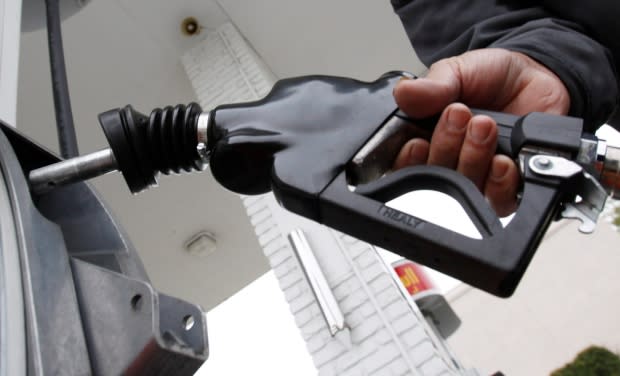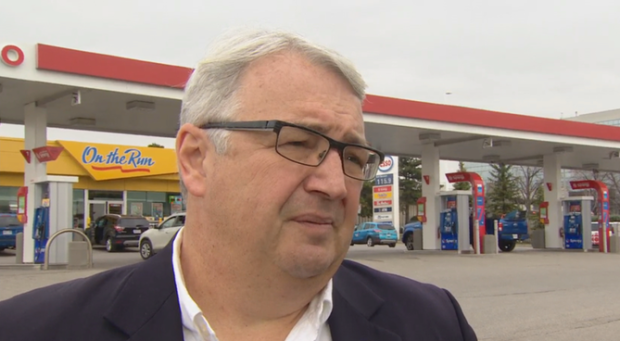Market forces point to higher gas prices, say experts
Warmer weather and tighter inventories of refined fuels are expected to keep gas prices from returning to 99 cents per litre, as they were earlier this year.
The latest jump in gas prices, bringing the price of a litre of gas to $118.7 in the Halifax area, can be traced mainly to supply and demand, says Paul Allan, executive director of the Nova Scotia Utility and Review Board. It sets minimum and maximum prices for gas across the province.
The maximum cost of gas outside of Halifax is currently $120.9 per litre.
Over the next few months, drivers could see the price of gas shoot up to $1.30 per litre, says Canadian petroleum analyst Dan McTeague of GasBuddy.com.
"We're seeing prices now that are a little higher than they were this time last year and we really haven't hit the summer driving season yet," he said. "The changeover from winter to summer blends of gasoline usually brings with it about a five-cent-a-litre increase on average."
He added that prices will surpass 2014 levels, which saw summer prices hover in the $1.40 range.
"Oil has really bounced back from its lows of Christmas at $42 a barrel," he said. "For some West Texas Intermediate it's back up to about $59 dollars a barrel, so it's picked up strength."

A falling Canadian dollar, which could bottom out at 62 cents against the U.S. dollar according to some economists, is another factor in the rising price of gas, McTeague said.
"This time last year, 128 pennies would buy you one U.S. dollar. Today, it's 133. That's good enough for a 1.4 cent increase in the price of gasoline [over last year] since we price all of our fuel in U.S. terms."
On Jan. 11, gas was selling in the Halifax area for 99.1 cents per litre and up to $1.01.2 in rural areas.
By Feb. 15, the price had climbed to $104.2 in Halifax and $1.06.4 in outlying areas. As of March 8, those figures have jumped to 114.3 and 116.4, respectively.
Supply and demand
Fluctuations in the price of oil affect the price of gasoline but it is only one of a number of factors, Allan said.
"Crude oil is about half the cost of gasoline, roughly. You can have all the crude oil in the world. But if you don't have a refinery to put it through, you've got nothing."
He said there are two things at work right now.
"One of them is the refined product inventories were very high. They were about 10 per cent higher than they were in previous years. So the old economics supply and demand laws all kick in. And if you've got a lot of something, price tends to fall.

"So because there was a lot of refined inventory around, people couldn't demand as high a price. So as those inventories are coming back down in line, there's a natural pressure for the price to come back up a bit."
Weather and driving patterns are also playing a role in the gas price increases, he said.
"We are now starting into the traveling period for North America. People don't like to drive in winter as much. But now that the ice and snow is going away, people are getting back out on the road."
The commodities market in New York sets the price of refined gasoline. The price is in American dollars and must be converted into Canadian dollars, according to the current rate of foreign exchange, which fluctuates.
"We are taking our cues from the New York Mercantile Exchange. So what happens in the states with a strong robust economy, where demand is very high, will continue to cast a toll shadow on prices for Canadians," McTeague said.
"If the U.S. drivers are putting demand on inventories then ... we're going to be competing."
The utility and review board uses the New York market figure as a baseline to set the price of gas for the coming week., Allan said.
"It's Thursday morning at 11 o'clock ... what you've got in front of you is a very simple sheet that shows the daily price each day for the last five days. So we look at last week and we use the last five trading days, kind of daily average in Canadian dollars, and we use that as the benchmark for the coming week," he said.

In addition, the board uses historical information to project ahead into the coming week. That feature is called "forward averaging," intended to stabilize pricing and balance the needs of consumers and the industry by anticipating how the market is moving compared to historic records.
Federal and provincial taxes, transportation adjustment, carbon costs and retail margins are added to the market figure.
Will prices continue to climb? Allan couldn't say.
But McTeague said prices will continue to rise and the next increase in Nova Scotia will be on Friday when gas will go up about 2.5 cents.
"So you'll be tiptoeing over the $1.20 threshold by midnight Thursday night."
MORE TOP STORIES

